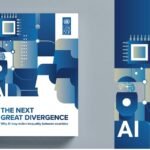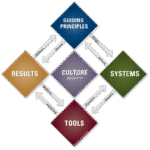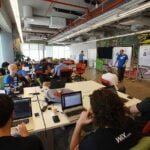The term bodystorming refers to a creative technique that combines physical action with critical thinking to generate innovative solutions. It emerged as an extension of traditional brainstorming, taking it to the next level by involving the body and space to visualize and tangibly experiment with ideas.
Bodystorming is an effective method for generating design ideas for movement-based interactions (Segura et al., 2016). As such, it is a flexible and powerful tool that can enhance the way we address problems and create human-centered solutions. It allows for active and creative idea generation and is ideal when the ideation challenge involves physical or interpersonal aspects.
This article introduces a definition of bodystorming, its principles, types, examples of use, and the procedure for conducting a bodystorming session.
What is Bodystorming?
Bodystorming can be defined as an ideation and prototyping technique that uses the body to generate ideas and experience situations. It is also known as “body brainstorming” or “brainstorming with the body.” However, there is no official name in Spanish yet.
In this way, bodystorming is particularly used in design and the resolution of complex problems. Instead of discussing concepts theoretically, participants physically immerse themselves in the situation, adopting roles, moving, and simulating real scenarios. This approach allows for a deeper understanding of user experiences, design challenges, or problems to solve.
As a group exercise, bodystorming involves communication through body language, kinesics, gestures, and proxemics, resulting in faster and more effective collaboration and communication among participants, clients, and stakeholders (Schleicher et al., 2010).
Principles of Bodystorming
Márquez et al., (2016) reported five fundamental principles that characterize bodystorming practice:
- Activity-Centered Focus
The design should focus on the activity itself rather than just on technology. In other words, the primary goal is to design a complete interactive experience that considers social, spatial, and physical aspects, with technology serving as support. The focus is on how people move, interact, and engage within a specific context, rather than solely on the technical features of the system. - Using Physical and Spatial Context as a Design Resource
The space where the activity takes place, along with the objects and elements within it, are considered important resources for design. Rather than viewing the environment as a mere backdrop, its characteristics are leveraged to inspire and shape the interaction. This involves observing how participants use the space, objects, and artifacts, and how these can influence the core mechanics of the activity or interaction. - Practical, Unscripted Activities
Bodystorming relies on practical experimentation and spontaneous action. Participants do not follow a predefined script but explore ideas freely through their bodies and movements. This freedom fosters creativity and allows new ideas to emerge naturally as designers interact with each other and the environment. Participants can adjust ideas on the fly, enriching the design process. - Movement and Play as Both Method and Goal
Movement and play are not only the object of design but also tools for generating ideas. Play is used to explore possibilities, experiment with actions, and create a safe environment for creative experimentation. Simultaneously, movement is essential for experiencing firsthand whether interactions work or not, making design a tangible experience. This principle aims to use designers’ bodily abilities as a creative resource. - Facilitating a Sensory and Creative Design Space
This principle involves creating an environment that fosters creativity, problem understanding, and solution exploration. The physical space should be comfortable, inspiring, and allow participants to feel safe exploring unconventional ideas. Artifacts such as props can help establish a playful and secure environment where designers feel free to experiment and take risks.
Importance of Bodystorming
Bodystorming, in its various forms, can be a valuable method in interaction design by incorporating bodily experience, context, and resource exploration (da Silva y Triska, 2024). Its flexible and adaptive nature makes it an essential tool for idea generation and concept exploration.
The primary value of bodystorming lies in its ability to foster empathy and a deep understanding of user experiences. By involving the body in the process, participants can move beyond abstract thinking and immerse themselves in the real context where a product or service will be used.
Here are some key reasons why bodystorming is important:
- Generates Empathy:
Participants “step into the user’s shoes,” simulating situations and interactions to experience users’ challenges and needs firsthand. - Encourages Creativity:
Acting out scenarios unlocks new ideas and perspectives that might not emerge in traditional brainstorming. - Allows Rapid Testing and Iteration:
Teams can quickly identify problems and refine solutions by simulating real-world scenarios. - Reveals Assumptions and Issues:
Acting as users helps uncover obstacles and challenges early in the design process. - Enhances Collaboration:
Bodystorming fosters better communication and teamwork by engaging participants in shared experiences. - Ideal for Physical and Spatial Contexts:
Especially useful for problems involving physical or spatial elements, such as AR or VR environments. For example, Boletsis et al., (2017) present Virtual Bodystorming as a promising method for service prototyping, offering a more realistic, engaging and collaborative alternative compared to traditional methods. - Memorable and Inspiring:
The physical and emotional involvement leaves a lasting impression, fostering a sense of purpose and connection with the project.
By facilitating practical solutions and fostering empathy, bodystorming becomes a critical tool in areas such as user experience (UX) design and design thinking.
Types of Bodystorming
Bodystorming, as an ideation method, has various adaptations that suit different contexts and design objectives. These variations share the characteristic of using the body as a central tool for generating ideas but differ in their focus and methodology. Below are the types of bodystorming identified in scientific literature:
Traditional Bodystorming
Essentially, it is a physical brainstorming session where participants explore ideas through action and simulation within the context of the design problem. This type of bodystorming can be conducted at the actual service location, in a similar setting, or in a workspace with simulation elements. The objective is to generate ideas, understand user needs, and receive quick feedback. Traditional bodystorming is characterized by three levels: observing, improvising, and reflecting.
Experience Prototyping
This variation relies on role-playing techniques and theatrical improvisation to investigate user needs, such as those of train passengers. It uses elements like support cards and, in some cases, a professional actor as a moderator.
Embodied Storming
This approach differs from other forms of bodystorming by prioritizing physical experience over ideation. Its primary goal is to foster experiential awareness and postpone the generation of specific ideas, thereby avoiding groupthink. It focuses on creating “scenarios” and the participation of a design group or “troop” rather than individual ideas.
User-Case Theater
This is the most popular form of bodystorming, involving the simulation of activities using actors and props in a prototypical space.
Strong Prototyping
This approach emphasizes the construction of physical spaces that simulate the environments where products or services will be used. The objective is to test prototypes in these controlled settings.
Embodied Sketching
Inspired by embodied storming, this variation focuses on an experiential design space that includes collaborative exploration and somatic practices. It aims to generate ideas through movement, playful activity, and body awareness.
Sensory Bodystorming
A hybrid method that combines embodiment and the use of materials to generate ideas based on sensory stimuli. Technologies that evoke sensory experiences are used alongside somatic training, such as yoga, to open the design space.
Wearable Mapping Suit
This method combines bodystorming with prototyping techniques for wearable technologies. It is based on body maps, a procedure for identifying parts of the body.
Remote Bodystorming
This variation uses virtual reality avatars to simulate the physical presence of participants in a collaborative environment.
Immersive Video Sketching (IVS)
This method integrates bodystorming with paper prototyping and video sketching, enabling the participation of non-design experts. It uses accessible tools and a physical environment that can be easily modified.
Performative Prototyping
Combines bodystorming with Wizard of Oz techniques and puppetry. It incorporates a dramaturgical perspective and somatic techniques for ideation.
Virtual Bodystorming
Conducted in virtual reality (VR) environments, this variation simulates service scenarios for prototyping and feedback gathering.
Bodystorming for Space Applications
Focuses on generating ideas for applications to be used in space, leveraging the body and environment as exploration elements.
These variations of bodystorming demonstrate the flexibility and adaptability of the method for different types of projects, ranging from interface design to urban planning. All variations share the use of action and bodily experience as catalysts for ideation and understanding the user’s perspective.
Bodystorming within the Design Thinking Framework
Bodystorming is one of the techniques used in the Design Thinking (DT) process for requirements elicitation (Kahan et al., 2024). It enables design teams to practically and actively experience and better understand users’ needs and experiences. Instead of merely discussing ideas in the abstract, bodystorming involves using the body to simulate situations, fostering empathy and generating more user-centered solutions.
Here’s how bodystorming integrates into Design Thinking:
Empathy Phase
Bodystorming is an excellent tool for the empathy phase of Design Thinking. By physically simulating users’ experiences, teams can better understand their needs, behaviors, and emotions in real-life contexts.
Participants step into the user’s shoes, acting out scenarios and tackling challenges as if they were the users themselves. This approach helps teams identify problems and opportunities that might not be evident through other research methods.
Ideation Phase
Bodystorming is also a highly effective ideation method.
Through movement and action, participants unlock new ideas and perspectives. The physical nature of this technique creates a more dynamic and creative environment for exploring solutions. Bodystorming encourages improvisation, often leading to unexpected and valuable insights.
Prototyping Phase
Bodystorming can serve as a quick and cost-effective prototyping method. By simulating interactions in a real-world setting, teams can test their ideas and concepts early and efficiently.
Simple physical prototypes, such as props, can be used to represent products or interfaces. This allows teams to identify issues and opportunities for improvement before investing in more expensive developments.
Iteration
Bodystorming is inherently iterative. As teams simulate and act out scenarios, they refine their ideas and concepts based on the feedback they receive from the experience. This leads to continuous improvement and stronger solutions.
Bodystorming is a valuable tool within Design Thinking because it enables teams to better understand their users, generate more creative ideas, test prototypes efficiently, and foster collaboration. By using the body to explore solutions, bodystorming helps teams create more user-centered products and services.
It’s important to remember that bodystorming requires preparation, sensitivity, and an experienced facilitator to ensure participants feel comfortable and the process remains productive.
Bodystorming: Differences from Other Techniques
If you’re wondering about the definition of bodystorming, this technique is based on embodying ideas to visualize, test, and refine solutions. It’s often confused with activities like role-playing or interactive workshops, but it has key differences:
- Total Immersion: Unlike other techniques, bodystorming is not just verbal; it involves movements, interactions, and complete simulations.
- Focus on Space: The physical environment plays a crucial role in bodystorming, enabling participants to adapt and experiment with real-time changes.
- Clear Objective: While brainstorming focuses on abstract ideas, bodystorming aims to develop practical and applicable prototypes.
For instance, in a service design project, the team might set up a space simulating a retail store and act as customers, employees, and managers to identify friction points.
Additionally, Lee et al., (2023) highlight that transitioning from brainstorming to bodystorming represents a shift toward more active and physical participation, incorporating body language, tangible materials, eye contact, tone of voice, and shared spaces to foster more effective and productive collaboration.
Practical Examples of Bodystorming in UX and Design
Bodystorming is used in the design of physical products, interior and exterior spaces, and even for solving complex problems. It is a valuable tool for user interface (UI) and user experience (UX) design, as well as for other fields like scientific research and education.
To better understand the potential of bodystorming, let’s explore some examples of bodystorming in action:
Designing a More Efficient Hospital
A design team used bodystorming to reorganize workflows in an emergency room. They simulated the movements of medical staff, patients, and visitors, identifying congestion points and unnecessary waiting times. This approach enabled them to implement changes that reduced response times in critical situations.
On a related note, Ishida et al., (2023) conceptualized the design of an overbed side table that integrates visualization technologies to facilitate information sharing between clinicians and patients. This table can be used to document patient information or hold meetings with other professionals in the patient’s room, in the hallway, or near the central nursing station.

Creating a Retail Customer Experience
In designing a new store, participants acted as shoppers and sales staff, testing different configurations of shelves and cash registers. Bodystorming helped create a more intuitive and engaging customer journey.
Healthy Spaces
Han et al., (2023) validated the effectiveness of bodystorming as a method for designing healthy spatial interfaces (HSI), particularly in vertical workspaces. The study provided valuable insights into how users interact with different areas of these spaces and their specific needs.
Designing a Urban Mobility App
A UX team worked on an app for booking electric bikes. They simulated scenarios such as searching for bikes on the street, using the app in the rain, and returning bikes at crowded stations. This allowed them to prioritize key features like quick access and real-time notifications.
Human-Robot Interaction (HRI) Spaces
Smart et al., (2024) highlighted the application and methodology of bodystorming in designing human-robot interaction (HRI), particularly in industrial settings, rather than focusing on specific robot designs. In this context, Porfirio et al., (2019) demonstrated that bodystorming, combined with the Synthé environment, enables designers—even without robotics or programming experience—to rapidly prototype human-robot interactions. The Synthé tool captures designers’ demonstrations.
These cases demonstrate how bodystorming can generate practical solutions that significantly enhance the user experience.
Benefits and Limitations of Bodystorming in Creative Processes
Benefits
- Fosters empathy by immersing participants in the user’s context.
- Encourages creativity and idea generation by moving away from abstract thinking.
- Allows rapid testing and iteration of ideas in real-world environments.
- Identifies problems and opportunities before investing in costly developments.
- Improves communication among team members.
Limitations
- May require significant resources and time to plan and execute.
- Some situations are difficult to simulate physically.
- Can be uncomfortable for some participants. Watanabe et al., (2024) reported that discomfort with acting was a common issue in interviews and varied depending on participants and representation approaches in bodystorming workshops.
- Can be subjective, as interpretations of physical simulations may differ among participants.
- Requires an experienced facilitator to ensure a safe and productive environment.
While not a perfect technique, bodystorming offers unique value in complex design processes.
How to Conduct a Bodystorming Session
Although there are many variations, the following are the general steps for conducting a bodystorming session:
Preparation
- Integrate prior knowledge: Consider incorporating existing insights into the session, such as through a research wall or key ideas.
- Invite relevant participants: Include individuals who can work alongside the core team, such as subject matter experts, users, service providers, implementation team members, and decision-makers. A mix of perspectives enriches the session.
- Warm-up activities: Some participants may feel uncomfortable at first, so icebreakers like improvisation games can help ease tension.
Immersion
- Immerse the group in the challenge’s context: For groups unfamiliar with the setting, visit the site during operating hours to observe without specific guidance. Conduct quick informal interviews or experience the service as a customer.
- Document the environment: Sketch or photograph the physical surroundings for later reference, and take brief notes. If the group is already familiar with the context, this phase can be replaced by storytelling.
Space and Props
- Work in the original context: Whenever possible, conduct the bodystorming in the actual service environment. If this is not feasible, use a workshop space and recreate the setting with relevant props and environmental elements. For example, a table and laptop could stand in for a counter and cash register.
Session Execution
- Use notes from the immersion phase or previous experiences to create a list of interesting situations or ideas.
- Role-play each situation: Participants act out scenarios, taking on roles of various stakeholders, groups, or platforms. This could involve reenacting sales pitches, ways of serving coffee, or simulating a website interface for customer interaction.
- Alternate roles: If necessary, switch roles to gain diverse perspectives. Document discoveries on a flipchart for easy recall. If the group is comfortable, video recordings may also be used, though they can slow down information retrieval.
- Repeat for other scenarios: Iterate the process with different situations or ideas.
- Reflect and prioritize: Discuss findings and decide which ideas to pursue further, possibly using a structured selection method.
Key success factors: Successful application depends on careful planning, effective facilitation, and tailoring the session to the specific group and context (Smart et al., 2024).
Tools and Resources for Effective Bodystorming
To maximize the effectiveness of bodystorming, certain tools and resources can facilitate the process, enabling participants to fully engage with the technique. These can be grouped into categories for preparation, execution, and analysis.
Physical Tools and Materials
- Adequate space: A spacious and flexible area where participants can move freely and simulate different scenarios. This could be the user’s real environment or an adaptable workshop space.
- Prototyping materials: Basic supplies like cardboard, paper, markers, adhesive tape, and other items for quick prototypes of products, interfaces, or environments. Real objects from the user’s setting can also serve as props.
- Environmental elements: Items like tables, chairs, or tablecloths can help recreate the context of use.
- Role and thought cards: Large cards can identify participant roles, while “thought bubble” cards show participants’ thoughts versus their spoken words.
- Documentation tools: Use a flipchart or whiteboard to record notes, findings, and questions. Video cameras can also capture sessions for detailed review.
- Audio elements: Background sounds can enhance immersion when appropriate.
Digital Tools and Resources
- Collaborative design software: Platforms like ShapesXR enable remote bodystorming by creating virtual environments and leveraging 3D elements.
- Virtual space-sharing platforms: Virtual Reality (VR) or Augmented Reality (AR) tools can simulate environments more immersively.
- Idea documentation and sharing apps: Use digital note-taking and organization tools to document and share ideas.
- 3D environment creation resources: Platforms like Sketchfab provide 3D models that can be integrated into virtual environments in ShapesXR.
Human Resources
- Facilitator: An experienced facilitator is essential to guide the session, ensure participant comfort, and maintain focus on the goal. They can also encourage exploration of more complex or challenging scenarios.
- Diverse participants: Include individuals from different roles and perspectives, such as users, experts, design team members, and implementers.
- Observers: External observers can document the process and offer additional insights.
Skills and Knowledge
- User context knowledge: A clear understanding of user needs, behaviors, and context is vital. This can be achieved through prior research, site visits, or user interviews.
- Improvisation skills: Participants should be willing to act, experiment, and build on each other’s ideas. Theater techniques like “Yes, and…” can foster this mindset.
- Empathy: Participants must step into the user’s shoes to understand their perspectives.
- Sensitivity: Ensure a safe and respectful environment for all participants, addressing diverse needs.
Conclusion
Bodystorming has established itself as a valuable tool for designers, innovators, and creative teams. Its hands-on and user-centered approach makes it a key technique for developing effective and meaningful solutions.
In an increasingly user-experience-driven world, bodystorming bridges ideas and realities, delivering tangible, empathetic results. From space planning to app design, its potential grows, particularly when combined with emerging technologies like virtual and augmented reality.
Ultimately, bodystorming transcends being merely a technique—it’s a bridge between theory and practice, ideas and real-world solutions.
References
Boletsis, C., Karahasanovic, A., & Fjuk, A. (2017). Virtual bodystorming: Utilizing virtual reality for prototyping in service design. In Augmented Reality, Virtual Reality, and Computer Graphics: 4th International Conference, AVR 2017, Ugento, Italy, June 12-15, 2017, Proceedings, Part I 4 (pp. 279-288). Springer International Publishing.
da Silva, C. C., & Triska, R. (2024). BODYSTORMING COMO PROCEDIMENTO PARA O DESIGN DE INTERAÇÃO: uma revisão sistemática integrativa da literatura. PPG Design Caderno Científico.
Han, D., Sun, X., Zhang, X., Yan, R., & Ren, X. (2023, October). Exploring Healthful Spatial Interface with Bodystorming: A Case Study from the Vertical Workspace Workshop. In Proceedings of the 2023 ACM Symposium on Spatial User Interaction (pp. 1-6).
Ishida, A., Martin, T., Gracanin, D., Franusich, D., Buck, C., Parker, S. H., … & Tasooji, R. (2023). Reimagining medical workspaces through on-site observations and bodystorming.
Kahan, E., Genero, M., & Oliveros, A. (2024). Refining a design thinking-based requirements elicitation process: Insights from a focus group. Science of Computer Programming, 237, 103137. https://doi.org/10.1016/j.scico.2024.103137
Lee, S. H., Yang, M. C., Coughlin, J. F., Lee, C., & Klopfer, E. (2023). From Brainstorming to Bodystorming: Co-Creation Workshop Analysis Using Applied Video Ethnography. Industrial Designers Society of America, New York, NY, The Watering Hole.
Márquez Segura, E., Turmo Vidal, L., & Rostami, A. (2016). Bodystorming for movement-based interaction design. Human Technology, 12(2), 193–251. doi: 10.17011/ht/urn.201611174655
Porfirio, D., Fisher, E., Sauppé, A., Albarghouthi, A., & Mutlu, B. (2019, October). Bodystorming human-robot interactions. In proceedings of the 32nd annual ACM symposium on user Interface software and technology (pp. 479-491).
Schleicher, D., Jones, P., & Kachur, O. (2010). Bodystorming as embodied designing. interactions, 17(6), 47-51.
Segura, E., Vidal, L., & Rostami, A. (2016). Bodystorming for movement-based interaction design. Human Technology, 12(2), 193–251. https://doi.org/10.17011/ht/urn.201611174655
Smart, W. D., Matheus, K., & Fraune, M. (2024). Applying bodystorming to human-robot interaction design. Amazon Science.
Watanabe, K., Otsuki, M., Kobayakawa, M., Kishita, Y., & Ho, B. Q. (2024, August). Acting out in real and virtual environments: comparative analysis for future workstyle design. In Proceedings of the Participatory Design Conference 2024: Exploratory Papers and Workshops-Volume 2 (pp. 73-80).
Editor and founder of “Innovar o Morir” (‘Innovate or Die’). Milthon holds a Master’s degree in Science and Innovation Management from the Polytechnic University of Valencia, with postgraduate diplomas in Business Innovation (UPV) and Market-Oriented Innovation Management (UPCH-Universitat Leipzig). He has practical experience in innovation management, having led the Fisheries Innovation Unit of the National Program for Innovation in Fisheries and Aquaculture (PNIPA) and worked as a consultant on open innovation diagnostics and technology watch. He firmly believes in the power of innovation and creativity as drivers of change and development.





